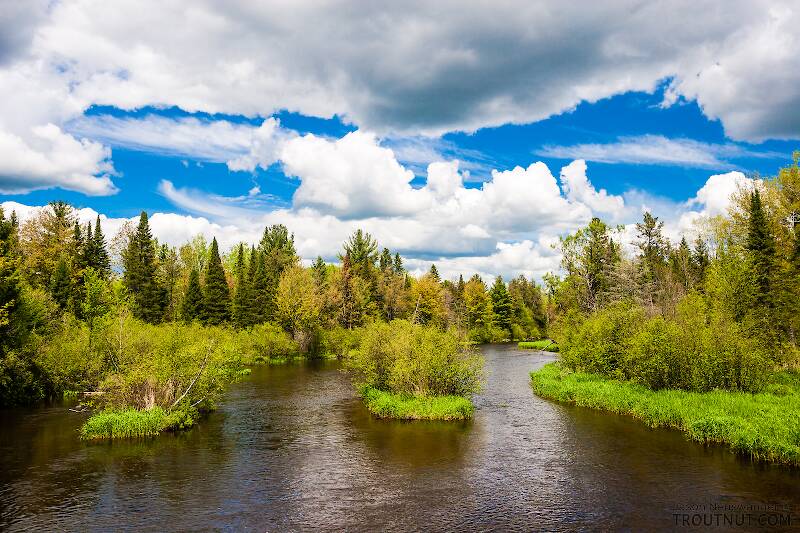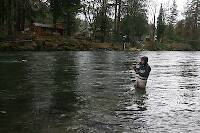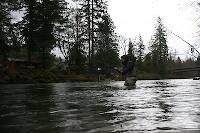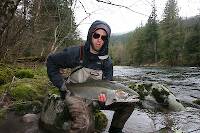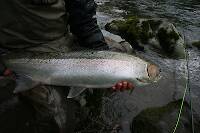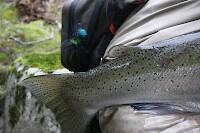
Salmonflies
Pteronarcys californica
The giant Salmonflies of the Western mountains are legendary for their proclivity to elicit consistent dry-fly action and ferocious strikes.
Featured on the forum

I was not fishing, but happened to be at an unrelated social event on a hill above this tiny creek (which I never even saw) when this stonefly flew by me. I assume it came from there. Some key characteristics are tricky to follow, but process of elimination ultimately led me to Sweltsa borealis. It is reassuringly similar to this specimen posted by Bob Newell years ago. It is also so strikingly similar to this nymph from the same river system that I'm comfortable identifying that nymph from this adult. I was especially pleased with the closeup photo of four mites parasitizing this one.

Troutnut is a project started in 2003 by salmonid ecologist Jason "Troutnut" Neuswanger to help anglers and
fly tyers unabashedly embrace the entomological side of the sport. Learn more about Troutnut or
support the project for an enhanced experience here.
Martinlf on May 20, 2007May 20th, 2007, 5:57 am EDT
Have any of you guys found a better way to set a dry fly (or any fly) down in windy conditions? Yesterday found me fishing in 15 mph winds, and from time to time when the gusts weren't at their peak, fish rose. I managed to catch a few, but casting in the wind is one of my greatest challenges. Even with fairly tight loops, it seems hard to get the fly down to the water with just the right s curves for a good drift. If you cast too close to the water, instant drag, if too high, the wind grabs fly, tippet, and line putting everything cattywampus. Any tips?
"He spread them a yard and a half. 'And every one that got away is this big.'"
--Fred Chappell
--Fred Chappell
GONZO on May 20, 2007May 20th, 2007, 6:48 am EDT
Louis, sidearm casts that are low to the water aid casting, but often don't allow enough time for the dry to orient on the fall. (But you probably already knew that.) Sometimes you can change your angle to take advantage of the wind. If upstream casts are into the wind, try a downstream angle. One tactic that works in some situations is to deliver the cast beyond and above the fish at a slight downstream angle. When the fly lands drag it into the fish's feeding lane and release slack into the drift. When all else fails switch to a nymph or wet in the film or slightly subsurface.
RleeP on May 20, 2007May 20th, 2007, 8:37 am EDT
On the pasture limestones of the midwest, wind plays the role that trees used to play on the small freestones of PA. It is THE primary PITA (pain in the arse). Lloyd is right, IMO, in the suggestions he makes. The only other tactic I know of is cast volume. I make 5 casts when it is really windy in order to get the lay and drift I want and can usually get with 2 casts when it is calm.
It can really test my already congenitally limited patience though. More than once I've walked off the creek because I felt about ready to get a rifle and find a bell tower....:)
Makes me loony...
It can really test my already congenitally limited patience though. More than once I've walked off the creek because I felt about ready to get a rifle and find a bell tower....:)
Makes me loony...
GONZO on May 20, 2007May 20th, 2007, 9:47 am EDT
Your post cracked me up, Lee. I empathize with your wind-driven lunacy (as does Louis, I'm sure). From a fly-casting perspective, the wind blows! ;)
Shawnny3 on May 20, 2007May 20th, 2007, 1:53 pm EDT
Let me preface my remarks by saying I hope nothing I say here insults Louis's intelligence. Please just disregard anything too obvious.
I agree that sidecasting is the biggest key. If you can get low enough you can almost completely eliminate the effect of the wind. Also, if you keep your backcast low as well, you can almost shoot your line underhanded and get your line to still roll over (that is, of course, unless your dry is just too bushy to cut the wind at all). I have developed kind of a sidearm motion naturally, so for me it's not so much of an adjustment as it is for some (for me the challenge is a straight overhead presentation). So you might want to practice sidearm casting even when you don't really need to use it. Another unrelated advantage to sidearm casting is being able to tuck casts under low-hanging limbs and brush. I know nothing makes me more pleased than catching a fish way up in under the crap when most people would just walk right by that spot.
I would also advise learning how to release accurately in the backcast, a skill I learned fishing the blustery lighthouse wall on Ithaca's Cayuga Lake. The only thing more aggravating than having all your line land in a heap on the water is having the wind blow your line back into your face and imbedding a fly travelling 600 mph in your person. I know Lefty Kreh advises that everyone learn how to cast left-handed to solve this problem, but I find that I can control my cast much better by casting right-handed but releasing the fly in my backcast.
Also, you might try double-hauling to give your line as much momentum as possible, even on casts you normally wouldn't need to double-haul.
And last, remember that when the wind picks up, it's just God's way of telling you to nymph. And when it really picks up, He's trying to tell you that there's a big ol' brown waiting for a really heavy streamer. And if He really wants you to go home, He'll strike a nearby tree (or your fishing partner) with lightning. Don't scorn the subtle advice of He who made both fish and fisherman...
-Shawn
I agree that sidecasting is the biggest key. If you can get low enough you can almost completely eliminate the effect of the wind. Also, if you keep your backcast low as well, you can almost shoot your line underhanded and get your line to still roll over (that is, of course, unless your dry is just too bushy to cut the wind at all). I have developed kind of a sidearm motion naturally, so for me it's not so much of an adjustment as it is for some (for me the challenge is a straight overhead presentation). So you might want to practice sidearm casting even when you don't really need to use it. Another unrelated advantage to sidearm casting is being able to tuck casts under low-hanging limbs and brush. I know nothing makes me more pleased than catching a fish way up in under the crap when most people would just walk right by that spot.
I would also advise learning how to release accurately in the backcast, a skill I learned fishing the blustery lighthouse wall on Ithaca's Cayuga Lake. The only thing more aggravating than having all your line land in a heap on the water is having the wind blow your line back into your face and imbedding a fly travelling 600 mph in your person. I know Lefty Kreh advises that everyone learn how to cast left-handed to solve this problem, but I find that I can control my cast much better by casting right-handed but releasing the fly in my backcast.
Also, you might try double-hauling to give your line as much momentum as possible, even on casts you normally wouldn't need to double-haul.
And last, remember that when the wind picks up, it's just God's way of telling you to nymph. And when it really picks up, He's trying to tell you that there's a big ol' brown waiting for a really heavy streamer. And if He really wants you to go home, He'll strike a nearby tree (or your fishing partner) with lightning. Don't scorn the subtle advice of He who made both fish and fisherman...
-Shawn
Jewelry-Quality Artistic Salmon Flies, by Shawn Davis
www.davisflydesigns.com
www.davisflydesigns.com
Troutnut on May 20, 2007May 20th, 2007, 3:19 pm EDT
I would also advise learning how to release accurately in the backcast, a skill I learned fishing the blustery lighthouse wall on Ithaca's Cayuga Lake. The only thing more aggravating than having all your line land in a heap on the water is having the wind blow your line back into your face and imbedding a fly travelling 600 mph in your person. I know Lefty Kreh advises that everyone learn how to cast left-handed to solve this problem, but I find that I can control my cast much better by casting right-handed but releasing the fly in my backcast.
That's a really interesting issue, and I actually hadn't heard of either of those solutions. I do get quite paranoid when the wind has me nearly hooking myself. One way I've resolved it is to cast with my arm angled across my body, so I'm casting on my left side with my right arm. Other times I just try to get a really high backcast. (I think I once heard a book call this a "tower cast" or something, but I'm not sure.)
I'm left-handed, but right-armed, a weird combination, and I'm pretty ambidextrous about most things. Maybe I should try casting with my left hand and see how it goes. I did OK fencing with that arm.
Jason Neuswanger, Ph.D.
Troutnut and salmonid ecologist
Troutnut and salmonid ecologist
Quillgordon on May 21, 2007May 21st, 2007, 12:18 am EDT
Jason says...
Well that explains everything! ........ LOL.
That would be a big asset with stream over-crowding.......
Cheers...
I'm left-handed, but right-armed, a weird combination, and I'm pretty ambidextrous about most things. Maybe I should try casting with my left hand and see how it goes. I did OK fencing with that arm.
Well that explains everything! ........ LOL.
I did OK fencing with that arm.
That would be a big asset with stream over-crowding.......
Cheers...
Flyfishing is a state of mind! .............. Q.g.
C/R........barbless
C/R........barbless
Quick Reply
Related Discussions
Topic
Replies
Last Reply
5
Oct 6, 2006
by Shawnny3
by Shawnny3
11
Oct 18, 2012
by Entoman
by Entoman
5
Mar 29, 2013
by Entoman
by Entoman

